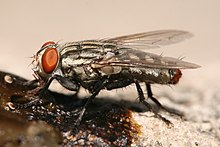
Flies are insects of the order Diptera, the name being derived from the Greek δι- di- "two", and πτερόν pteron "wing". Insects of this order use only a single pair of wings to fly, the hindwings having evolved into advanced mechanosensory organs known as halteres, which act as high-speed sensors of rotational movement and allow dipterans to perform advanced aerobatics. Diptera is a large order containing an estimated 1,000,000 species including horse-flies, crane flies, hoverflies and others, although only about 125,000 species have been described.
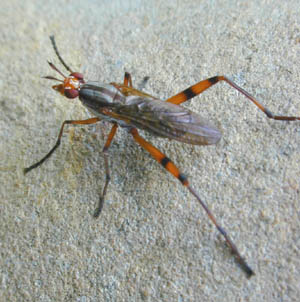
The Acalyptratae or Acalyptrata are a subsection of the Schizophora, which are a section of the order Diptera, the "true flies". In various contexts the Acalyptratae also are referred to informally as the acalyptrate muscoids, or acalyptrates, as opposed to the Calyptratae. All forms of the name refer to the lack of calypters in the members of this subsection of flies. An alternative name, Acalypterae is current, though in minority usage. It was first used by Pierre-Justin-Marie Macquart in 1835 for a section of his tribe Muscides; he used it to refer to all acalyptrates plus scathophagids and phorids, but excluding Conopidae.

Muscoidea is a superfamily of flies in the subsection Calyptratae. Muscoidea, with approximately 7000 described species, is nearly 5% of the known species level diversity of the Diptera, the true flies. Most muscoid flies are saprophagous, coprophagous or necrophagous as larvae, but some species are parasitic, predatory, or phytophagous. In September 2008, a study was done on the superfamily using both nucleic and mitochondrial DNA and the conclusion suggested that Muscoidea may actually be paraphyletic.

Oestroidea is a superfamily of Calyptratae including the blow flies, bot flies, flesh flies, and their relatives. It occurs worldwide and has about 15,000 described species.

Hippoboscoidea is a superfamily of the Calyptratae. The flies in this superfamily are blood-feeding obligate parasites of their hosts. Four families are often placed here:

In insect anatomy, the juxta is an organ in the males of most Lepidoptera that supports the aedeagus, the organ used for reproduction in insects. The juxta is located between the two valvae. Juxta has also been used to refer to a similar structure in fleshflies.
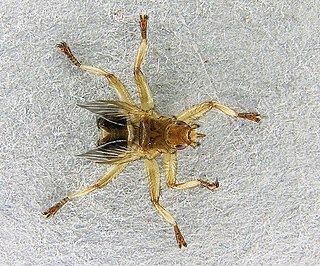
Hippoboscidae, the louse flies or keds, are obligate parasites of mammals and birds. In this family, the winged species can fly at least reasonably well, though others with vestigial or no wings are flightless and highly apomorphic. As usual in their superfamily Hippoboscoidea, most of the larval development takes place within the mother's body, and pupation occurs almost immediately.

The Streblidae are a family of flies in the superfamily Hippoboscoidea, and together with their relatives the Nycteribiidae, are known as bat flies. They are winged or wingless ectoparasites of bats, and often have long legs. They appear to be host-specific, with different species of bat flies occurring only on particular species of bat hosts, sometimes with multiple species of flies sharing a host bat.

Nycteribiidae is a family of the true fly superfamily Hippoboscoidea are known as "bat flies", together with their close relatives the Streblidae. As the latter do not seem to be a monophyletic group, it is conceivable that bat flies cannot be united into a single family.

The Chironomoidea are a superfamily within the order Diptera, suborder Nematocera, infraorder Culicomorpha. This superfamily contains the families Chironomidae, Ceratopogonidae, Simuliidae, and Thaumaleidae.

The Empidoidea are a large monophyletic superfamily of true flies, the sister taxon to the Muscomorpha (Cyclorrhapha). These two groups are sometimes united in the unranked taxon Eremoneura. There are some 10,000 known species within Empidoidea, which are represented on all continents except Antarctica. They are known to have existed since the Jurassic period.

Tipuloidea is a superfamily of flies containing the living families Cylindrotomidae, Limoniidae, Pediciidae and Tipulidae, and the extinct family Architipulidae. A common name for it is crane flies, which is also applied specifically to family Tipulidae.
Apystomyia is a genus of flies in the family Apystomyiidae. The genus contains the single living Apystomyiidae species, Apystomyia elinguis, which is primarily found in California. Details of its life history are largely unknown. The extinct genus Hilarimorphites is known from the Cretaceous Burmese and New Jersey ambers. Formerly placed in the Asiloidea, molecular phylogenetic studies in 2010 placed the genus unambiguously as a sister of the Cyclorrhapha within the clade Eremoneura.
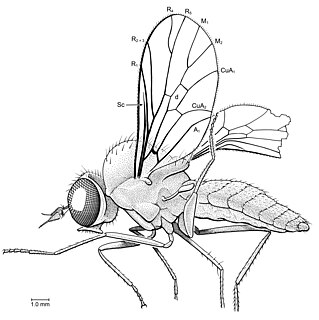
Apystomyiidae is a small family of flies containing the living genus Apystomyia and the extinct genera Apystomimus and Hilarimorphites. The single living Apystomyiidae species, Apystomyia elinguis, is native to California. Species of Hilarimorphites have been described from Mid to late Cretaceous Burmese and New Jersey ambers, while the single Apystomima species is from the Late Jurassic of Kazakhstan.
Ulurumyia macalpinei is a species of fly in the superfamily Oestroidea endemic to Australia. It was first discovered in the 1970s, but was not described until 2017, and in the intervening decades was informally known to entomologists as McAlpine's fly. It is said to be clearly distinct from other oestroid families but its exact position within the superfamily has not been determined with certainty. The genus name Ulurumyia is derived from Uluru, also known as Ayers Rock, Australia, and myia, the Greek word for fly; the species name macalpinei commemorates the Australian dipterist David K. McAlpine, the first person to collect specimens of this fly and realize their evolutionary distinctiveness.

Enischnomyia is an extinct genus of bat fly in the family Streblidae. At the time of its description the new genus comprised a single species, Enischnomyia stegosoma, known from a single Miocene fossil found on Hispaniola. E. stegosoma was the first fossil streblid bat fly described from a fossil, and the only member of the subfamily Nycterophiliinae described from Hispaniola. The species is host for the plasmodiid Vetufebrus ovatus preserved in its salivary glands and midgut.
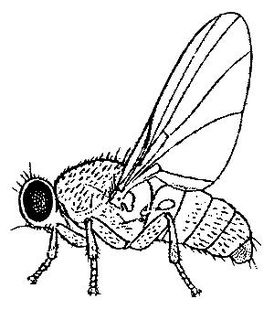
Fergusonina, the sole genus in the family of Fergusoninidae, are gall-forming flies. There are about 40 species in the genus, all of them producing galls on Eucalyptus, Melaleuca, Corymbia, and Metrosideros species in Australia and New Zealand.
Eremoneura is a clade of flies within the Brachycera that includes the Empidoidea and the Cyclorrhapha and is a sister of the Asilomorpha. They are thought to have evolved around the Mesozoic. The group includes fossils described in the genus Chimeromyia from 125 million year old amber which show both empidoid and cyclorrhaphan characters. The monotypic family Apystomyiidae has also been placed within the Eremoneura as a sister of the Cyclorrhapha.

Mesembrinellidae is a family of Neotropical flies in the order Diptera, and formerly included in the Calliphoridae. There are 36 described species.
